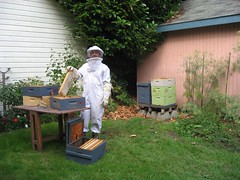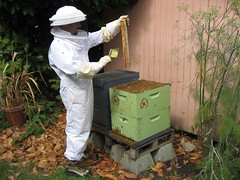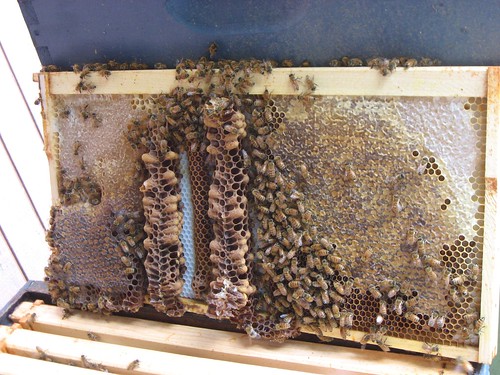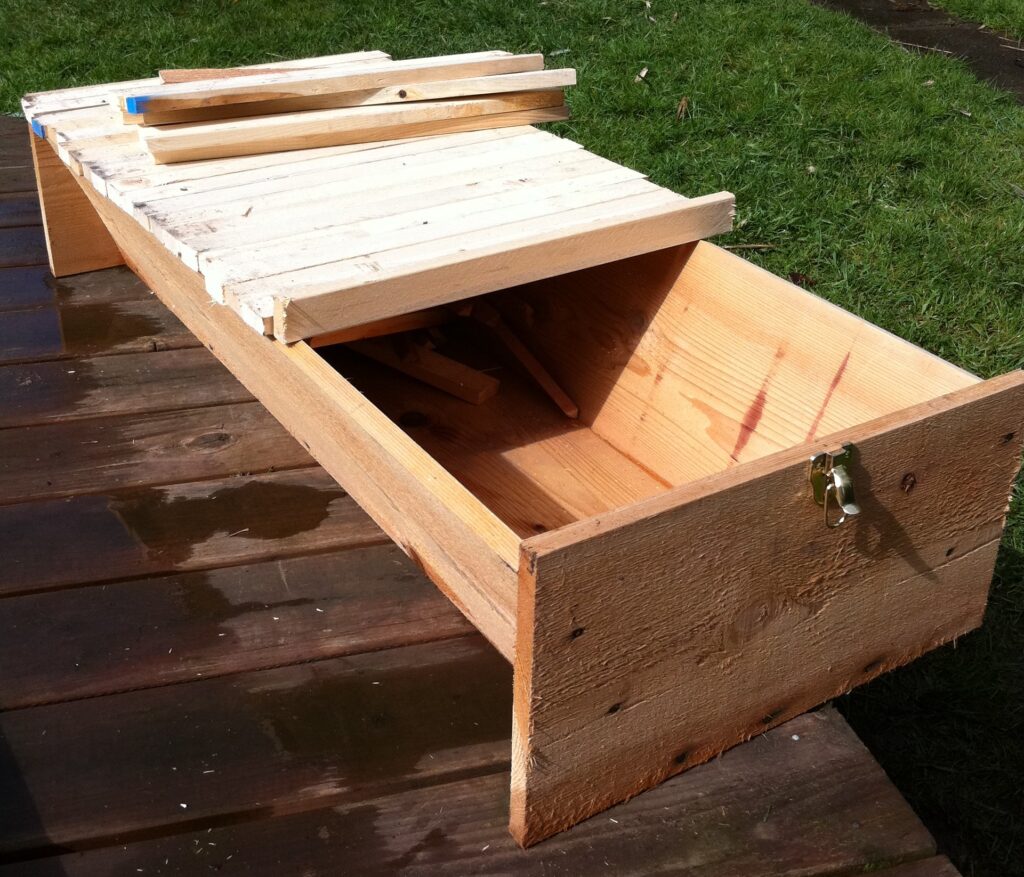It’s honey harvest time! It’s honey harvest time!
After a fortifying meal of fried eggs and coffee (sweetened with the only thing a self-respecting beekeeper would sweeten his coffee with, his very own home made honey, natch), I suited up and began the process of harvesting the sweet fruits of my (well, my girls’) labor.
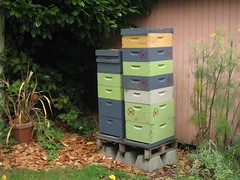 As you can see on the right, I had some high hopes for what kind of harvest I’d see. Look at that! Five honey supers on the hive on the right (Hive 2) and two on the hive on the left (Hive 1; the final box on the top there is a feeder). Why, that should probably yield somewhere between a jillion and a double gadjillion gallons of honey!
As you can see on the right, I had some high hopes for what kind of harvest I’d see. Look at that! Five honey supers on the hive on the right (Hive 2) and two on the hive on the left (Hive 1; the final box on the top there is a feeder). Why, that should probably yield somewhere between a jillion and a double gadjillion gallons of honey!
OK, maybe not so much, but it does look to be quite a bit. Not all of the supers turned out like I’d hoped, but it still turned out pretty…errr…sweet.
I set up a little work triangle in the back yard:
- The bee hives
- A work table a little bit away from the hives
- A “clean room” area where I would put the supers that had been completely cleared of bees
I’m not so naive as to think that the bees wouldn’t make it over into my “clean room”, but it felt a bit less messy and would at least reduce the number of hitchhikers I’d have on my trip to the extractor later in the day.
I cracked open Hive 1 first. My thinking was that they were less productive (I think because they were getting less sun), so any mistakes I made should be on them rather than on the more valuable Hive 2. As it turned out, everything went smoothly, and no major mistakes were made.
One by one, I carried the supers over to my work table, pulled out the frames, and moved the empty super over to my “clean room”. I took each of the frames individually over to the hive and gently swept all the bees off it with a bee brush (a soft-bristled hand broom). Free of bees, I dropped it into the empty super and moved on to the next one.
While, like I said, I didn’t make big mistakes, there were a few surprised along the way. First, I was reminded again of why I don’t like plastic frames. Look at the weird laying patter on the this plastic frame in Hive 1. See how the bees are avoiding building up on the frame itself, and instead are building off perpendicular to it? And it may be a bit hard to tell from the picture below, but off to the left there, they’ve built a second, parallel comb with a gap between it and the plastic. Weird, yo.
I am totally not buying plastic again.
Also disappointing were the number of uncapped frames I found. I got a full, solid ten frame super out of Hive 1 and expected to get four ten frame supers out of Hive 2, but a full super and a half of Hive 2 was completely uncapped.
Uncapped means that the honey is still curing and will have too high a water content to store (it can ferment if there’s too much moisture in it). The bees will keep it warm and evaporate out the moisture and, when it’s down to the right consistency, they cap each of the cells with wax to preserve it. Uncapped cells mean too much moisture means I can’t harvest it. The pictures below are of a single frame, one side capped (on the right) and one side not (on the left).
Ideally, those cappings go all the way to the edge (bottom). The slightly different colored cells in the bottom middle are just from a different point in the season when a different set of flowers were in bloom.
I put the uncapped frames in a couple of supers and loaded them back onto the hives. If I can’t harvest them, the bees can still eat them. It’ll give ’em a little something extra to chew on over the winter.
As each super was cleared, I loaded it into the back of my car, and when it was all done, Michelle and I headed up to Everett to have them extracted. We got a ton of pictures of that process and Mike, the beekeeper doing the extracting had a trove of information for us on how to improve our beekeeping operation, but it’s late, so that’ll have to wait until tomorrow.
Here’s a teaser, though: he hates plastic, too.


